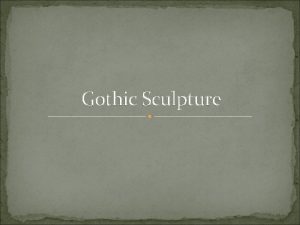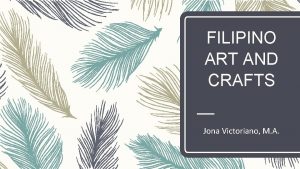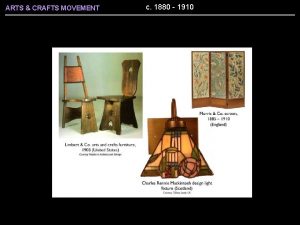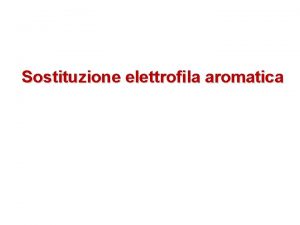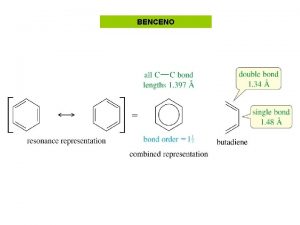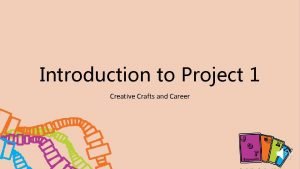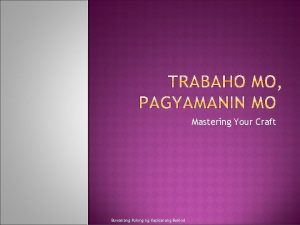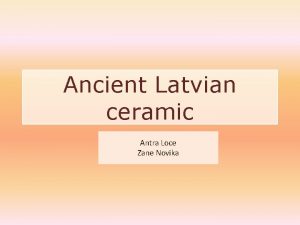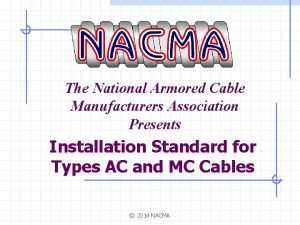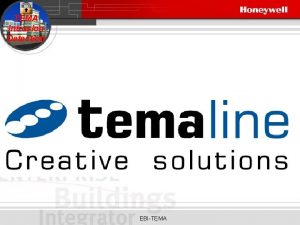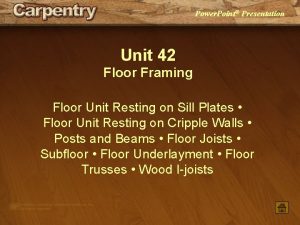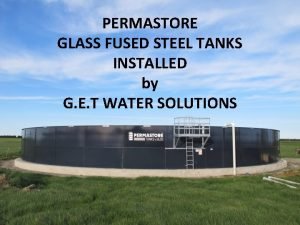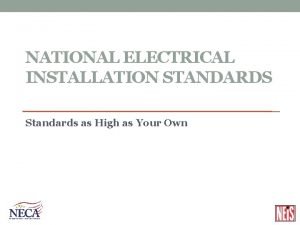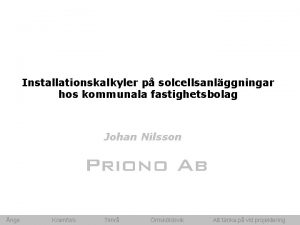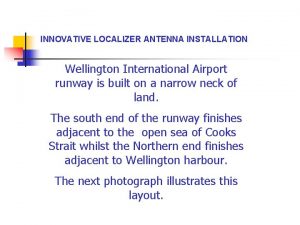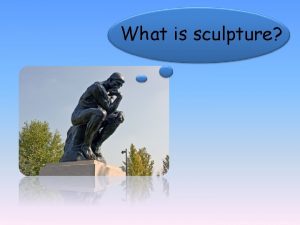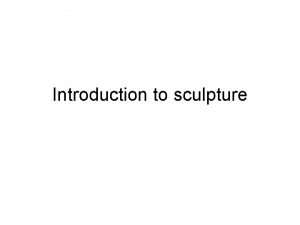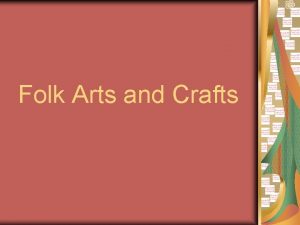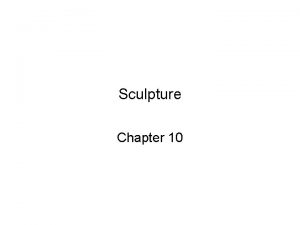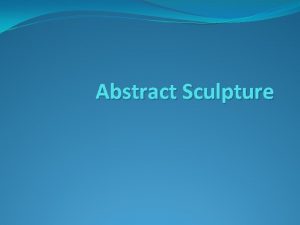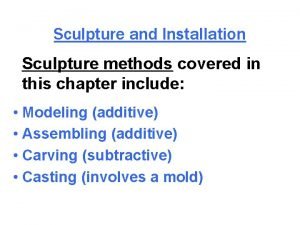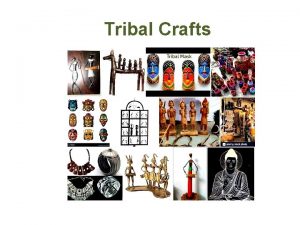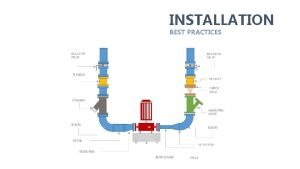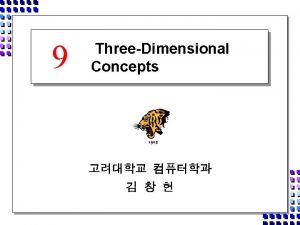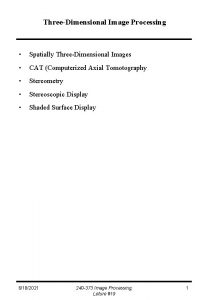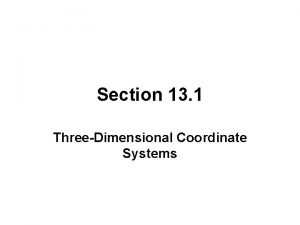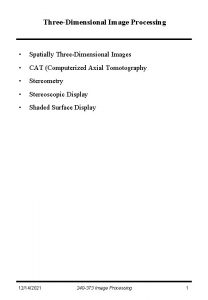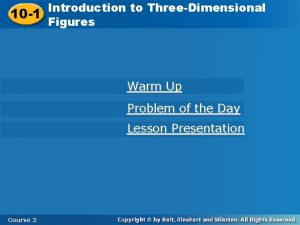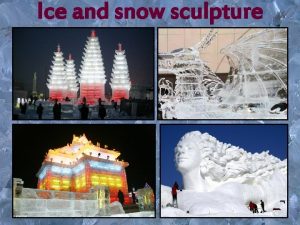THREEDIMENSIONAL MEDIA SCULPTURE AND INSTALLATION Crafts Architecture Sculpture
















































- Slides: 48

THREE-DIMENSIONAL MEDIA SCULPTURE AND INSTALLATION Crafts Architecture

• Sculpture is defined as a three dimensional work of art (such as a statue). • Sculpture is the action or art of processing (as by carving, molding, or welding) plastic or hard materials into works of art. • There are four basic methods for making a sculpture: modeling, casting, carving, and assembling.

Louis Bourgeois. Maman. 1999. Bronze, steel, and marble; height 30’

SCULPTURE AND INSTALLATION

• Modeling and assembling are considered additive processes. • Carving is a subtractive process in which one starts with a mass of material larger than the planned sculpture and subtracts, or takes away, material. • Casting involves a mold of some kind, into which liquid or semi liquid material is poured and allowed to harden.

Modeling Clay is the most common material sculptors use. Clay can be manipulated as long as it is wet. When the clay is dried and fired it becomes hard. Fired clay is called by the Italians terra cotta. • Sculptors use same way as painters use drawing to test out ideas before committing to final work • Example built up by hand, then sensitively worked with tools of stone/wood.

Casting seems to be more of an indirect process for creating a sculpture. The most common method is the lost-wax process, sometimes known as by the French name, cire perdue.

Investment Casting • Mold formed around solid sculpture • Silicone is usually mold material • Melted wax slushed around inside mold to about 3/16” thick • Once hardened, wax casting removed, checked for accuracy Exact duplicate, but hollow • Casting fitted with wax rods, pins, encased in solid plaster (investment) From here on process same as previous • Key difference • Mold makes wax casting reusable • Multiple wax versions - editions

Luis Jimenez. Vaquero. Modeled 1980, cast 1990. Acrylic urethane , fiberglass, steel armature, height 16’ 7” fiberglass

Carving • Carving is more aggressive than modeling, more direct than casting. • The process involves the sculptor begins with a block of material and cuts, chips and gouges away until the form of the sculpture emerges. • Materials are usually wood or stone.

Olowe of Ise. Bowl with figures. Early 2 oth century. Wood, pigment; height 25”

Colossal Head. Olmec, 1500 -300 B. C. E Basalt, 8’

Assembling • Assembling is a process by which individual pieces or segments or objects are bought together to form a sculpture. • Some people make a distinction between assembling, in which parts of the sculpture are placed on or near each other and constructing, in which the parts are actually joined together through welding, nailing or a similar procedure. • Direct casting is the use of the object itself, such as a leaf, which is fitted with wax rods and encased in plaster.

XI Books III Apples, 1959 David Smith

David Smith. Cubi IX. 1961. Stainless Steel, 8’ 93/4”x 4’ 105/8” x 3’ 77/8”

Mark di Suvero Origins, 2001 -2004, Painted steel 36’ 7”x 18’ 3”x 17’ 10”

• Petah Coyne, Untitled #1111 (Little Ed’s Daughter Margaret). 2003 -2004. Wax, fiberglass cast statuary, velvet, satin, ribbon, thread, steel understructure, PVC pipe and fittings, tree branches, fabricated tree branches, chickenwire fencing, wire, silk flowers, pearl-headed hat pins, tassels, feathers, pumps, irrigation tubing, water, hair, spray paint and acrylic paint, 11' high.

Direct casting is the use of the object itself, such as a leaf, which is fitted with wax rods and encased in plaster. Nancy Graves. Extend-Expand. 1983 bronze with polychromed patina, 7’ 1”x 4’ 3”

Alexander Calder. Ordinary. 1969. painted steel, 19’x 19’ 8 ¾” x 19’ stationary mobile

Relief sculpture • Relief sculpture is work that is viewed from one side only. • Relief sculpture is three-dimensional but not in the round. It is used to decorate architecture or functional objects. • When a sculpture projects more from the background it is called high relief (or haut-relief). • Low relief (bas relief) – coins are examples of low relief. • High relief (haut relief) – projects by at least half its depth from a background.

Sarcophagus Lid, from the Temple of Inscriptions, 684 B. C. E. Limestone Low relief (bas relief)


High relief (haut relief) Durga Fighting the. Buffalo Demons, Mahishamardini Cave.

Sculpture in the round Auguste Rodin. The Burghers of Calais


The Human Figure in Sculpture


Contrapposto • Contrapposto is a stance developed by Greek artist for standing figures. Contrapposto, meaning “counterpoise” or “counterbalance, ” sets the body in a gentle S-shaped curve through a play of opposites

Contrapposto

Michelangelo. The Dying Slave 1513 -16. Marble

Henry Moore abstract human sculptural forms that complemented the English landscape.

Kiki Smith. Honey wax. 1995. Beeswax,

Environmental sculpture • 1. Sculptures you can walk into and thru • 2. Sculptures displayed outdoors • 3. Sculptures that are part of the natural landscape. • Working with TIME and PLACE

Serpent Mound, near Locust Grove, Ohio. C. 1070 c. e. overall length c. 1300’ Adena culture constructed ritual shapes, called “effigy mounds

Richard Serra’s Tilted Arc in Manhattan 120 ft long, 12 ft high slab of Cor. Ten steel Federal Plaza in Lower Manhattan Public Art

Andy Goldsworthy. Reconstructed Icicle, Dumfriesshire, 1995. Icicles, reconstructed and refrozen

Icestar

Coulibaly Siaka Paul, with photographs by Malick Sidibe The Clubs of Bamako

Richard Hunt. Jacob’s Ladder. 1997. Bronze, 18’ Site specific

Louis Bourgeois. Red Room (Child), exterior. 1994. Installation: wood, metal, thread, glass


Dan Flavin. Untitled (to Karin and Walther), from the European series. 1996 -71

Minimalist artists believed that art should offer a pure and honest aesthetic experience instead of trying to influence people through images or transmit the ego of the artist through self expression.

Christo and Jeanne Claude. Wrapped Reichstag. Berlin. 1971 -1995 • Christo and Jeanne-Claude: Projects such as the running fence and Wrapped Reichstag live on afterwards in preparatory sketches, photographs, books, and film. Their art is not just the end result, but the entire process from planning through dismantling, including the way it energizes people and creates relationships




Jeff Koons Puppy Flowers, Plants
 Gothic sculpture vs romanesque sculpture
Gothic sculpture vs romanesque sculpture Manobo crafts
Manobo crafts Arts and crafts movement 1880 to 1910
Arts and crafts movement 1880 to 1910 Where did pawnee live
Where did pawnee live Sostituzione elettrofila aromatica
Sostituzione elettrofila aromatica Pentecost welcome
Pentecost welcome Aromaticidad
Aromaticidad Vacation bible school crafts
Vacation bible school crafts Indigenous creative crafts module
Indigenous creative crafts module Introduction to indigenous creative crafts
Introduction to indigenous creative crafts Benzene acylation
Benzene acylation Bakit kailangang hangarin ang excellence sa trabaho
Bakit kailangang hangarin ang excellence sa trabaho Zane loce
Zane loce People as media vs people in media examples
People as media vs people in media examples Windchill bulk migrator
Windchill bulk migrator Plc installation troubleshooting and maintenance
Plc installation troubleshooting and maintenance Sa power networks service and installation rules
Sa power networks service and installation rules Electrical estimating and costing
Electrical estimating and costing Plc troubleshooting guide
Plc troubleshooting guide Return architecture
Return architecture Difference between hot and cold media
Difference between hot and cold media Hot media and cold media
Hot media and cold media Advantages and disadvantages of wired and wireless networks
Advantages and disadvantages of wired and wireless networks Hot and cold media
Hot and cold media Tru count air clutch repair
Tru count air clutch repair Nec derating table
Nec derating table Honeywell tema server installation manual
Honeywell tema server installation manual Technisonic avionics installation
Technisonic avionics installation Solar installation summit county
Solar installation summit county Sonar nexus
Sonar nexus Standard installation unifi
Standard installation unifi Smoke detector installation kentucky
Smoke detector installation kentucky Chapter 10 floor framing answers
Chapter 10 floor framing answers Permastore
Permastore Nm interlock indigent fund
Nm interlock indigent fund Ansi/neca 1-2015
Ansi/neca 1-2015 Meter installation/removal
Meter installation/removal Refnet joint installation
Refnet joint installation Spectrum net selfinstall activation
Spectrum net selfinstall activation Installation solceller timrå
Installation solceller timrå Tv aerial installation wellington
Tv aerial installation wellington Knx kommunikation
Knx kommunikation Gree versati 3
Gree versati 3 Gps lockbox installation instructions
Gps lockbox installation instructions Fusioncompute installation steps
Fusioncompute installation steps Fso installation
Fso installation Winfeed
Winfeed Containment solutions installation manual
Containment solutions installation manual Tesla charging stations in montana
Tesla charging stations in montana
